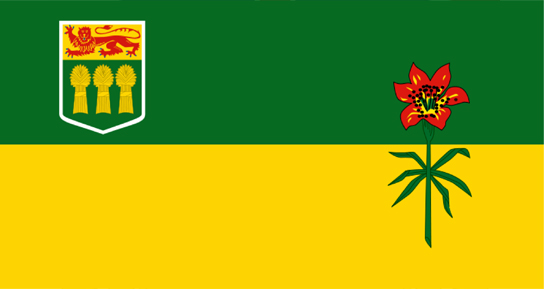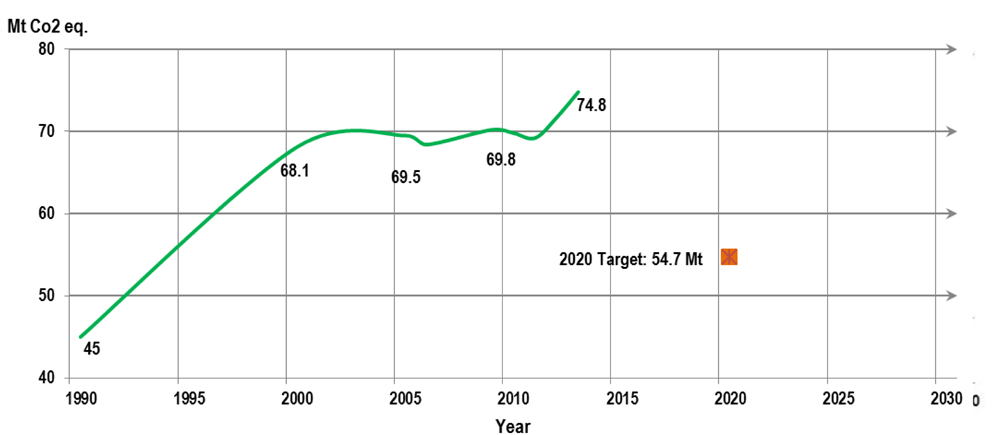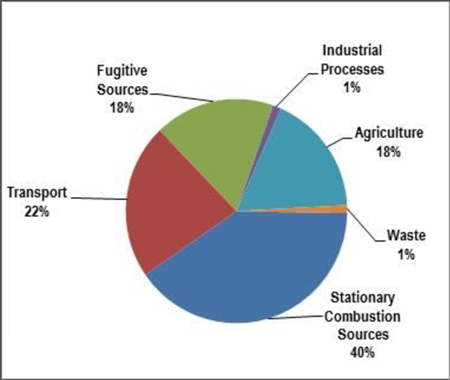Saskatchewan: Environment profile
Note
This information was current as of November 2015.

Saskatchewan (SK) in brief
- Premier:
- Hon. Brad Wall (Saskatchewan Party)
- Population:
- 1,125,400 (2014)
- Total Area:
-
651,036 km
2
- Land:
- 591,670 km 2
- Freshwater:
- 59,366 km 2
- Real GDP (gross domestic product) 2013:
- $62.7 billion (in 2007 dollars)
- Contribution to real Canadian GDP 2013:
- 3.7%
SK budget 2015-16
- Budgeted total expenditures:
- $14.2 billion
- Funds allocated to Minister of Environment (MoE):
-
$162.8 million
- 1.1% of total budget
- 0.7% decrease from 2014-15
Key environmental federal-provincial/territorial agreements
- South of the Divide Multi-Species Action Plan
- Canada-SK Administrative Agreement
- Canada-SK Environmental Occurrences Notification Agreement
- Canada-SK MOU on Hydrometric Monitoring
- Canada-SK Agreement on Species at Risk
- Saskatchewan Protocol Agreement on
Water - Agreement Concerning the Implementation of the North American Waterfowl Management Plan And Other Bird Conservation Through the Prairie Habitat Joint Venture
Climate change
- Department responsible for climate change:
- Ministry of Environment
- Minister responsible for climate change:
- Hon. Herb Cox
- Legislation and regulations:
- The Management and Reduction of Greenhouse Gases and Adaptation to Climate Change Act (not yet proclaimed), the Ethanol Fuel Act, the Management and Reduction of Greenhouse Gases Regulations (not yet proclaimed)
Saskatchewan’s GHG (greenhouse gas) emissions and 2020 target

Source(s):
- National Inventory Report (2015)
- 2020 target: Management and Reduction of Greenhouse Gases Regulations (2009)
Long description
Figure 1 presents a single time series line graph with the horizontal axis spanning the years 1990 to 2030 in five year increments. The vertical axis is Mt CO2 eq and spans the value of 40 to 80 in increments of 10. The starting value in 1991 is 45 Mt and trends upwards to 68.1 Mt in 2000, 69.5 Mt in 2005, 69.8 Mt in 2010 and 74.8 Mt in 2013. The provincial 2020 target of 54.7 Mt is noted.
Provincial GHG emissions reduction targets
- 20% below 2006 levels by 2020
- The 2020 target was proposed in the Management of Reduction of Greenhouse Gases Regulations, but has not been proclaimed
- 2020 Target Equivalent to a 2005 baseline: 21% below
SK’s sources of GHG emissions, 2013

Source: National Inventory Report, 2015
Long description
Figure 2 presents a pie chart of the distribution of major greenhouse gas sources in Saskatchewan.
- Stationary combustion sources: 40%
- Transport: 22%
- Fugitive sources: 18%
- Industrial processes: 1%
- Agriculture: 18%
- Waste: 1%
- Climate change strategies: Go Green Plan (2008), Management and Reduction of Greenhouse Gases Regulations (not finalized)
- Total SK emmissions, 2013: 74.8 metric tonnes (Mt) (Source: National Inventory Report, 2015)
- SK contribution to total Canadian GHG emissions, 2013: 10.3%
- Ranked 4th largest GHG emitter among Canadian provinces and territories in 2013
- GHG per capita, 2012: 68.8 tonnes; ranked highest GHG emitter per capita, 2012
- SK has invested over $1 billion to retrofit the Boundary Dam coal fired power station with carbon capture and storage technology. The federal government committed $240 million towards the project. The refurbished power plant became operational in October 2014. SK has also invested upwards of $17 million in carbon capture and storage projects to reduce flaring.
- The 2008 Go Green Fund commits $70 million to support household energy efficiency programs and small scale renewable energy initiatives including solar, wind and biomass; SK mandates a 7.5% ethanol blend in gasoline.
- SaskPower is doubling its wind power capacity and expects wind power to account for 9% of its total generating capacity by 2019.
- Proposed GHG regulations would require major emitters to reduce emissions to meet the provincial target.
Water
- Departments responsible for water:
- Ministry of Environment, Water Security Agency
- Minister responsible for water:
- Hon. Herb Cox
- Legislation and regulations:
- Saskatchewan Environmental Code, Saskatchewan Watershed Authority Act, Environmental Management and Protection Act, Watershed Associations Act, Conservation and Development Act, Water Power Act
- Water strategies: Environment Plan for 2014-15 (2014), 25-Year Water Security Plan (2012), 10-Year Water Management Infrastructure Renewal Plan (2012), Boreal Watershed Management Strategy (2011)
- The SK Water Security Agency, established in 2012, is responsible for all programs and services associated with municipal drinking water and wastewater operations, and affiliated surface and ground protection. Its mission is to ensure sustainable water supplies, safe drinking water, safe and effective infrastructure, and protection of water quality and aquatic habitats.
- The MoE’s Plan for 2014-15 has three broad goals: ensure audit, compliance and enforcement of Saskatchewan Environmental Code, protect waters of the northern boreal watersheds, and protect source water through monitoring of source industrial sites and compliance activities.
- In 2012, SK released its 25-Year Water Security Plan to ensure sustainable surface and groundwater and clean drinking water sources, and mitigate water shortages and deteriorating water quality. It sets out the following goals: sustainable supply of ground and surface water; safe drinking water; healthy and well-functioning ecosystems; safe dams that meet water supply and management needs; reduction of flood and drought damage; adequate water data; information and knowledge to support decision making; and coordinated, comprehensive and collaborative management and decision making processes.
- The objective of the 10-Year Water Management Infrastructure Renewal Plan is to rehabilitate priority structures, including upgrades to Gardiner Dam and enlarging and rehabilitating the M1 Canal.
Environment Canada and SK collaboration on water
- Mackenzie River Basin Board
- Prairie Provinces Water Board
- Canada-Saskatchewan MOU on Hydrometric Monitoring
- Canada-Saskatchewan Protocol Agreement on Water
Biodiversity and wildlife
- Department responsible for biodiversity and wildlife:
- Ministry of Environment
- Minister responsible for biodiversity and wildlife:
- Hon. Herb Cox
- Legislation:
- Conservation Easements Act, Ecological Reserves Act, Environmental Assessment Act, Environmental Management and Protection Act (passed but not yet proclaimed), Fisheries Act (Saskatchewan), Forest Resources Management Act (passed but not yet proclaimed), Natural Resources Act, Prairie and Forest Fires Act, Provincial Lands Act, State of the Environment Report Act, Wildlife Act, Wildlife Habitat Protection Act
- Biodiversity and conservation strategies: Saskatchewan Prairie Conservation Action Plan Framework 2014-2018, Caring for Natural Environments: A Biodiversity Action Plan for Saskatchewan’s Future (2004 to 2009) (no longer available on SK government website)
| Extirpated | Endangered | Threatened | Special Concern | |
|---|---|---|---|---|
| Total: 63 Source: Species at Risk Public Registry January 2015 |
3 | 16 | 23 | 21 |
- A partnership of industry, federal and provincial government agencies, and non-government and educational organizations delivers prairie conservation activities under the Saskatchewan Prairie Conservation Action Plan Framework 2014-2018.
- South of the Divide Stewardship in Action is a joint initiative of the governments of Canada and Saskatchewan to conserve species at risk in the Milk River Watershed in southwestern Saskatchewan. The goal of the project is to conserve species at risk and their supporting habitats by collaborating with land owners and land users.
- Percentage of freshwater and land protected in SK: 8.5% (Source: Canadian Environment Sustainability Indicators, 2013).
- Environment Canada maintains 23 protected areas in SK, including 8 National Wildlife Areas and 15 Migratory Bird Sanctuaries, comprising over 77,000 hectares of SK’s protected lands and waters.
- It is estimated that between 17% and 21% of the original native prairie remains intact in SK (Source: Prairie Conservation Plan Framework, 2014-18).
- The Allan/Dana Hills of Saskatchewan contain the some of the highest waterfowl breeding densities on the continent (Source: Ducks Unlimited).